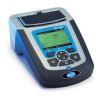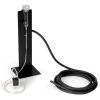Hach DR3900 Laboratory VIS Spectrophotometer
The Hach DR3900 is a benchtop visible spectrum, split beam spectrophotometer for laboratory water analysis.
Features
- Simple Preparation with TNTplus® vials
- Store hundreds of user-determined methods
- Claros™ connectivity
- Free ground shipping
- Expedited repair and warranty service
- Lifetime technical support
- More
Overview
The Hach DR 3900 is a benchtop visible spectrum (320-1100 nm) split beam spectrophotometer with over 220 pre-programmed methods optimized for laboratory water analysis. The DR3900 spectrophotometer is optimized for safe processes and accurate results daily. Control parameters like Ammonium, COD, Phosphate, Nitrate and many others are easy to test.
Simple Preparation
TNTplus® vials use Dosicaps - freeze-dried reagents integrated into a sealed cap - that are easier to use than Powder Pillows or Liquid Reagents, without any risk of contamination. The boxes and vials are color-coded for fast and easy parameter and range recognition of the test needed. Step-by-step illustrated test methods are printed on the box as a quick reference and can also be called up in the instrument menu.
Comprehensive Documentation
Measurement results are documented on a detailed level with a timestamp, operator ID, absorbance reading, and calculated concentration. The 2D barcode delivers the lot number and expiry date, logged with every result. For accreditation, the certificate of analysis can be called up just by wiping the reagent box towards the RFID sensor.
Fast Execution
The Hach DR 3900 spectrophotometer automatically reads a 2D barcode on the TNTplus vial to identify the appropriate method and take the measurement. The vial spins to take 10-fold absorbance readings that will be averaged for result determination to exclude scratches and fingerprints. Instrument calibration verification and high instrument stability all combine to eliminate the need to run reagent blanks.
Customizable
With the ability to store hundreds of user-determined methods, operators are able to tailor the DR 3900 to meet the everyday needs of the facility. Optimizing and customizing the method portfolio, combined with regular software updates and Claros™ connectivity, makes the DR3900 the ultimate solution to water quality lab needs.
- Beam Height: 10 mm
- Data Logger: 2000 measured values (Result, Date, Time, Sample ID, User ID)
- Display: 7" TFT
- Display Resolution: WVGA (800 pix x 480 pix)
- Display Size: 7 inch (17.8 cm)
- Display Type: Colored touch-screen
- Enclosure Rating: IP30
- Interfaces: USB type A, (2)USB type B, Ethernet, RFID module
- Light Source: Gas-filled Tungsten (visible)
- Manual Languages: English, French (CDN), Spanish (SA), Portuguese (BR),Chinese, Japanese, Korean
- Max. operating humidity: 80 %
- Max. Storage Humidity: 80 %
- Operating Conditions: 10 - 40 °C
- Operating Mode: Transmittance (%), Absorbance and Concentration, Scanning
- Optical System: Reference beam, spectral
- Photometric Accuracy: 5 mAbs @ 0.0 - 0.5 Abs
- Photometric Accuracy 2: 1 % at 0.50 - 2.0 Abs
- Photometric Linearity: < 0.5 % - 2 Abs
- Photometric Linearity 2: ≤ 0.01 % at >2 Abs with neutral glass at 546 nm
- Photometric Measuring Range: ± 3.0 Abs (wavelength range 340 - 900 nm)
- Power Requirements: With external power supply
- Power Requirements (Hz): 50/60 Hz
- Power Requirements (Voltage): 110 - 240 V AC
- Power Supply: Benchtop Power Supply
- Preprogrammed Methods: > 240
- Region: US
- Sample Cell Compatibility: Rectangular: 10, 20, 30, 50 mm, 1 inch; round: 13 mm, 16 mm, 1 inch
- Scanning Speed: > 8 nm/S (in steps of 1 nm)
- Source Lamp: Gas-filled Tungsten (visible)
- Specific Technology: RFID for easy method update, sample ID and Certificate of Analysis
- Spectral Bandwidth: 5 nm ± 1 nm
- Standard accessories: None
- Storage Conditions: -30 - 60 °C
- Stray Light: < 0.1 % T at 340 nm with NaNO2
- User Interface Languages: Bulgarian, Chinese, Croatian, Czech, Danish, Dutch, English, Finnish, French, German, Greek, Hungarian, Italian, Japanese, Korean, Polish, Portuguese - Brasilian, Potuguese, Russian, Serbian, Slovakian, Slowenian, Spanish, Swedish, Turkish
- User Programs: 100
- Warranty: 12 months
- Wavelength Accuracy: ± 1.5 nm (wavelength range 340 - 900 nm)
- Wavelength Calibration: Automatic
- Wavelength Range: 320 - 1100 nm
- Wavelength Reproducibility: ± 0.1 nm
- Wavelength Resolution: 1 nm
- Wavelength Selection: Automatic, based on method selection
- Weight: 4.2 kg
- (1) DR3900 Spectrophotometer
- (1) Adapter A for 1 in. round and 1 cm square cells
- (1) Matched pair of 1 in. square glass sample cells
- (1) Light shield
- (1) Dust cover
- (1) Printed basic user manual
- (1) Benchtop power supply with 115 and 230V power cords
In The News
Poás Volcano Gives a Glimpse of Life on Mars
To get an idea of what life would be like on Mars, you don’t need to travel millions of miles away--instead, you could go to Costa Rica and visit the Poás Volcano and its crater lake, Laguna Caliente. “Collectively, the suite of alteration minerals at Poás crater and identified across Mars at relict hydrothermal sites shows strong correlation, indicating the high temperature and highly acidic geochemical processes occurring at Poás are quite relevant to understanding past hydrothermal processes on Mars,” says Justin Wang, a graduate student at the University of Colorado, Boulder. He is currently conducting research at the Laboratory for Atmospheric and Space Physics alongside his advisor, Brian Hynek. Wang is currently a master's student in aerospace engineering.
Read MoreWave-Powered Buoy Deployed in Puget Sound
While the development of solar-powered monitoring systems has improved access to real-time environmental data, solar power is still limited by low light conditions, such as poor weather, nighttime, or high-latitude environments. To supplement these incumbent power solutions at sea, Ocean Motion Technologies has developed a small-scale ocean wave energy system that can be directly integrated with existing data buoy platforms. Not only does wave energy supplement solar power during periods when the buoys are limited by light availability, but it also allows data buoys to perform beyond their current power capacities.
Read MoreLong-Term Monitoring in the Chautauqua Lake Watershed
With a widely developed shoreline, Chautauqua Lake experiences influxes of non-point source pollution that have historically impacted the health of the lake. The Chautauqua Lake Association (CLA) has been monitoring the lake for over two decades, reporting on changes that have occurred over the years. A pair of local lake advocates, Jane and Doug Conroe, have lived on the lake for over 40 years and have played an important role in establishing monitoring programs and facilitating consistent data collection throughout the watershed. Doug has been involved with the Chautauqua Lake Association (CLA) since the pair moved to the area in 1980, and is currently serving as the Executive Director.
Read More



















































































